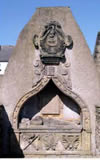St Mary's Kirkyard Banff
![]() In the heart of Banff, one of the most important sea-ports in medieval Scotland, are the remains of the parish church of St Mary’s. The story that it, and the burials around it, can tell is intimately bound up with the changing fortunes of the burgh of Banff itself and the surrounding countryside.
In the heart of Banff, one of the most important sea-ports in medieval Scotland, are the remains of the parish church of St Mary’s. The story that it, and the burials around it, can tell is intimately bound up with the changing fortunes of the burgh of Banff itself and the surrounding countryside.
The parish kirk of St Mary’s that was rebuilt in 1471 was not the first church in Banff, but it is the earliest to survive, at least in part. This was a long, stone building, aligned east-west, with porch and an aisle protruding to the south. The demolition of 1797 spared this aisle as it had by then become the burial place of one of the most important families in Banffshire, the Ogilvies (the kirk had been rebuilt when Sir James Ogilvie of Deskford was Provost; the chaplain was paid 10 merks by the town).
The tomb that was put up in 1558 is an elaborate late medieval wall tomb with substantial canopy. The ground level of the surrounding kirkyard was raised about 1815 when the kirkyard was laid out with paths and shrubs in a form of ‘graveyard gardening’, a term used at the time.
The surviving aisle of the old kirk has a pointed vault (which opened to the church) with a substantial window framed with stone mullions or cross bars. It shows the high standard of mason work required by the burghers. It has crow steps to the gables and is now slated, although originally it may have been thatched.
The Banff Aisle was restored in 2003 as part of Aberdeenshire’s Historic Kirkyards project, with assistance from Historic Scotland and the Heritage Lottery Fund.
 In the surrounding kirkyard you will find the tombs of the people of Banff from the 17th to the 19th century: masons, provosts, saddlers, ministers, teachers, soldiers, all together. Note the small 1765 stone on the left of the path to the aisle which has a full relief figure of Death, with his scythe and hourglass on the back.
In the surrounding kirkyard you will find the tombs of the people of Banff from the 17th to the 19th century: masons, provosts, saddlers, ministers, teachers, soldiers, all together. Note the small 1765 stone on the left of the path to the aisle which has a full relief figure of Death, with his scythe and hourglass on the back.
 Bairds of Auchmeddan
Bairds of Auchmeddan
An impressive canopied tomb of 1636 to George Baird, combining medieval and Renaissance elements. The recumbent warrior figure in armour, with dog at his feet, is in the, by then archaic, late-medieval tradition (cf Ogilvie tomb), but the ogee-shaped arch and over-sized baroque escutcheon over it were up to the minute touches.
Sharp monument
 This great classical tomb, on the eastern boundary of the kirkyard, is an extravagant statement of belief in an afterlife and of the status of the family of the archbishop murdered by Covenanters near St Andrews in 1679. Dating from 1698, it is covered with symbols of death and resurrection. Below the elaborate flanking pilasters are a skull and sexton’s tools, with a full skeleton between. The top, by contrast, carries winged figures bearing trumpets and the Book, symbolising triumph over death.
This great classical tomb, on the eastern boundary of the kirkyard, is an extravagant statement of belief in an afterlife and of the status of the family of the archbishop murdered by Covenanters near St Andrews in 1679. Dating from 1698, it is covered with symbols of death and resurrection. Below the elaborate flanking pilasters are a skull and sexton’s tools, with a full skeleton between. The top, by contrast, carries winged figures bearing trumpets and the Book, symbolising triumph over death.
Further information can be found in the leaflet St Mary's Kirkyard, Banff (PDF 349KB) produced by Aberdeenshire Council.
Information regarding the survey undertaken in 1998 on St Mary's Kirkyard can also be downloaded.
